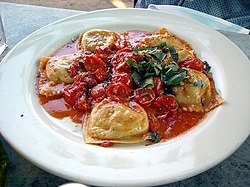Marinara sauce
 A plate of ravioli alla marinara | |
| Course | Main course |
|---|---|
| Place of origin | Italy |
| Region or state | Naples |
| Serving temperature | Hot over pasta |
| Main ingredients | Tomatoes, garlic, onions, basil |
| Variations | Olives, capers |
| Part of a series on |
| Pizza |
|---|
Marinara (English: mariner's) sauce is an Italian sauce that originated in Naples, usually made with tomatoes, garlic, herbs, and onions.[1][2] Its many variations can include the addition of capers, olives and spices.[3][4] It is occasionally sweetened with a dash of red wine.
This sauce is widely used in Italian-American cuisine, which has greatly diverged from its Old World origins. Mostly referred to as Marinara in the United States of America, it is more correctly known as Napolitana sauce in other parts of the world. Marinara making reference to the inclusion of seafood ingredients in a tomato base.
Italians refer to marinara sauce only in association with other recipes. For instance, spaghetti alla marinara literally translates to "spaghetti mariner's style" (from the adjective marinara with the feminine suffix -a pertaining to salsa, Italian for sauce), but tomato sauce alone in Italy is called sugo/salsa al/di pomodoro or pummarola (the latter being Neapolitan language).
Origin
Several folk theories exist as to the origin of this sauce: One version states that cooks aboard Neapolitan ships invented marinara sauce in the mid-16th century after Spaniards introduced the tomato (a New World fruit) to Europe. The original recipe did not contain seafood, so it was resistant to spoilage due to the high acid content of tomatoes. This made it ideal for lengthy sea voyages hundreds of years before refrigeration methods were invented. Another theory states this was a sauce prepared by the wives of Neapolitan sailors upon their return from sea.[5]
Historically, however, the first Italian cookbook to include tomato sauce,[6] Lo Scalco alla Moderna (The Modern Steward), was written by Italian chef Antonio Latini and was published in two volumes in 1692 and 1694. Latini served as the Steward of the First Minister to the Spanish Viceroy of Naples.[6][7][8] This early tomato sauce was more like a modern tomato salsa.
See also
References
- ^ "Definition of marinara sauce on the Oxford Dictionary website". Retrieved 10 December 2013.
- ^ "Definition of marinara sauce on the Your Dictionary website". Yourdictionary.com. 17 April 2013. Retrieved 3 May 2013.
- ^ "Giada Delaurentis' recipe for marinara sauce". Foodnetwork.com. Retrieved 3 May 2013.
- ^ Mario Batali (5 October 2007). "Mario Batali's recipe for marinara sauce on the Serious Eats website". Seriouseats.com. Retrieved 3 May 2013.
- ^ "Info on the origin of marinara sauce on the Italian Chef website". Italianchef.com. 24 April 2013. Retrieved 3 May 2013.
- ^ a b Elizabeth David, Italian Food (1954, 1999), p 319, and John Dickie, Delizia! The Epic History of the Italians and Their Food, 2008, p. 162.
- ^ Alan Davidson, "Europeans' Wary Encounter with Tomatoes, Potatoes, and Other New World Foods" in Chilies to Chocolate: Food the Americas Gave the World, (University of Arizona Press) 1992.
- ^ Origins of Italian tomato sauce Foodtimeline.org. Retrieved 23 April 2011
External links
 Marinara Sauce at the Wikibooks Cookbook subproject
Marinara Sauce at the Wikibooks Cookbook subproject

